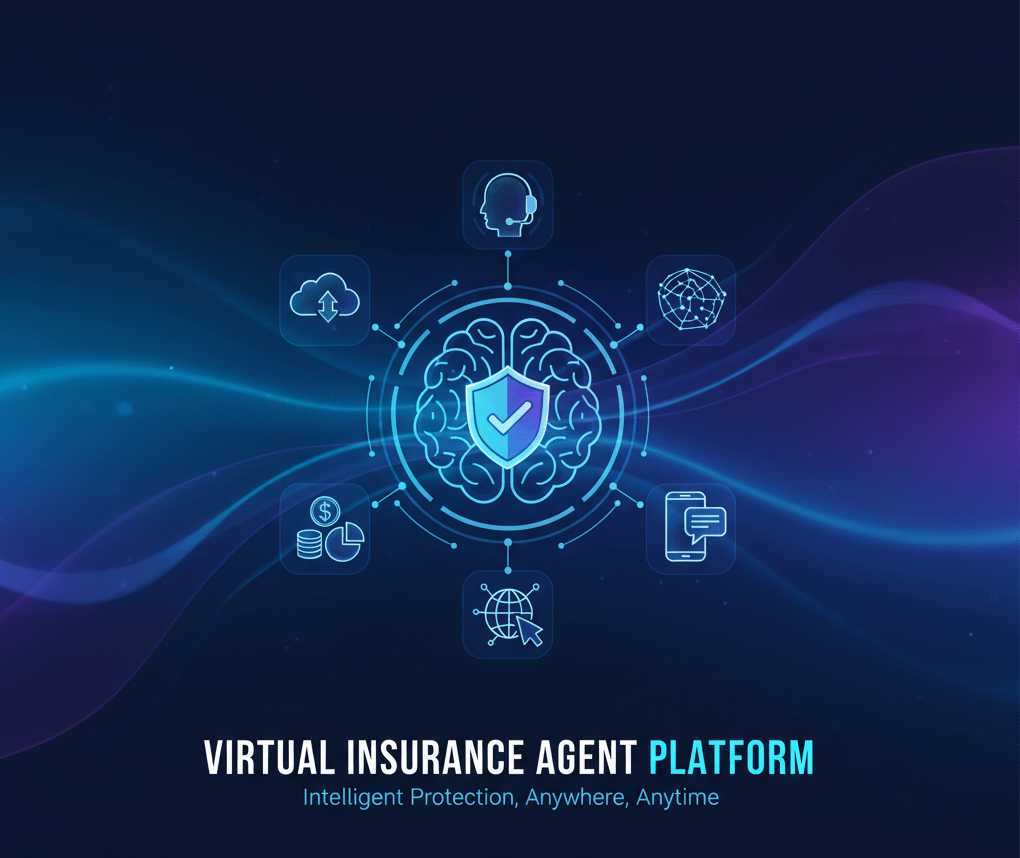“Launch a Virtual Insurance Agent Platform with no-code tools to provide 24/7 quoting, instant FAQ answers, and automated lead capture.”
The phone rings. It’s 6:30 PM. You missed it. It was probably the prospect from your website that finally prompted me to consider life insurance after putting the kids to bed. That’s a lost opportunity. A few hours later, an email comes in. A current client has a simple question about their auto policy deductible. They won’t get an answer until you’re back at your desk tomorrow morning. By then, their slight worry might have grown into frustration.
This is the daily reality for thousands of independent insurance agents and small brokerages. You’re the heart of your business. You build the relationships, provide the expert advice, and close the deals. But you’re also the head of customer service, the lead qualifier, and the administrative assistant. There are only so many hours in the day, and you can’t be available 24/7.
Or can you?
What if you could clone yourself? Imagine a version of you that never sleeps, never takes a vacation, and can instantly answer 80% of the questions that flood your inbox and voicemail. A version of you that captures every single lead from your website, day or night, and even provides them with an instant, accurate quote. This isn’t science fiction. This is the power of a virtual insurance agent.
For years, this kind of technology felt out of reach—something reserved for the massive national carriers with billion-dollar IT budgets. It seemed complex, expensive, and required a team of developers. That has completely changed. Today, thanks to the rise of no-code platforms, any insurance professional with the drive to grow can build and launch their own powerful digital assistant.
This article is your playbook. We’ll walk you through the entire process, step by step, from concept to launch. You’ll learn how to build a 24/7 workhorse for your agency without writing a single line of code. We’ll be using Scalewise.ai as our example because it’s a free and compelling virtual insurance agent platform explicitly designed for people like you—the ambitious insurance entrepreneur who wants to scale. Get ready to build the best employee you’ve ever had.
Why Your Agency Needs a Virtual Agent (Like, Yesterday)
Before we dive into the “how,” let’s talk about the “why.” Implementing a virtual agent isn’t just about adding a cool gadget to your website; it’s about enhancing the overall user experience. It’s a fundamental shift in how you operate, a strategic move that addresses the biggest challenges facing modern agencies.
Meet the Modern Customer’s Expectations
Consider how you purchase items today. If you want to order a pizza, book a flight, or buy a book, you expect to be able to do it instantly, from your phone, at any hour. Your clients and prospects are no different. They don’t want to wait for office hours to get a simple answer or a quote. When a question pops into their head, they want an answer now. A digital insurance agency that meets this demand for instant gratification has a massive competitive advantage. A virtual agent puts your business on par with the big players, offering the 24/7 quoting and support that customers now consider standard.
Become a 24/7 Lead Generation Machine
How many potential clients visit your website after you’ve already closed up for the day? A lot. Without a way to engage them, they are just anonymous clicks. They might fill out a “Contact Us” form, or they might simply leave and visit a competitor’s site that offers an instant quote. A chatbot for insurance brokers is the ultimate tool for capturing leads on insurance websites. It proactively engages every visitor, asking questions, qualifying their needs, and, most importantly, capturing their contact information. Hence, you have a hot lead waiting for you first thing in the morning. It turns your website from a passive brochure into an active, round-the-clock salesperson.
Automate the Mundane, Focus on the Meaningful
Take a moment and think about the questions you answer over and over again. “What are your hours?” “How do I file a claim?” “Can you explain what ‘comprehensive coverage’ means?” Each time you answer one of these, you’re spending valuable minutes on a task that a machine could handle perfectly. This is the core of insurance sales automation. By offloading these repetitive queries to a virtual agent, you free up your time and mental energy. You can then focus on the high-value activities that actually grow your business, such as advising a high-net-worth client on an umbrella policy, negotiating a complex commercial package, or networking to build new relationships.
Empower Your Clients with Self-Service
Today’s consumers love to be in control. They prefer finding answers themselves before having to pick up the phone. A virtual agent can act as a powerful customer self-service portal. It provides your clients with instant access to their policy information, enabling them to understand their coverage and initiate the First Notice of Loss (FNOL) process at their own convenience. This not only improves their experience and satisfaction but also reduces the number of routine service calls your agency has to handle. It’s a win-win.
Scale Your Agency Without Scaling Your Payroll
Growth is exciting, but it comes with its share of growing pains. More clients mean more phone calls, more emails, and more administrative work. The traditional solution is to hire more staff, which brings on significant costs in salary, benefits, and training. A virtual agent is a force multiplier. It allows a single agent or a small team to handle the workload of a much larger agency. It can manage hundreds of conversations simultaneously without getting overwhelmed. This is how you scale your insurance agency intelligently, growing your revenue and client base without your overhead costs exploding. You’re not just working harder; you’re working smarter. This is the essence of insurtech entrepreneurship: leveraging technology to build a more efficient, profitable, and future-proof business.

Part 1: The Blueprint – Defining Your Virtual Agent’s Role
Before you start building anything, you need a plan. Think of it like hiring a new employee. You wouldn’t just hire someone and say, “Go do stuff.” You’d create a clear job description outlining their responsibilities, goals, and what success looks like. Building your virtual agent is the same process.
You don’t need to make it do everything at once. The key is to start with the most impactful and high-value tasks, and then expand their capabilities over time. Here are the four primary roles your virtual agent can fill. Pick one to start.
Role #1: The Quoting Specialist
This is often the biggest game-changer. For many agencies, providing instant quotes is the holy grail. It directly addresses the primary need of a vast segment of your website visitors and is one of the most powerful lead generation tools you can have.
- What it does: The virtual agent guides a user through a series of simple questions to collect the necessary information for a quote (e.g., ZIP code, date of birth, vehicle information, desired coverage level).
- Where to start: Don’t try to replicate a complex, multi-carrier rating system on day one. Start simple. Select one or two straightforward products, such as renters insurance or term life insurance. These have fewer variables and are easier to set up. You can even offer “ballpark” or “indicative” quotes for auto insurance to capture the lead, with a clear disclaimer that a final rate requires speaking with an agent.
- Information to collect: Map out the exact data points you need to collect. For a renter’s quote, the required information may include the property address, coverage amount for personal property, and liability limit.
- How it delivers: At the end of the conversation, the virtual agent can display the premium right in the chat window. Crucially, it should also request an email address to send a copy of the quote, thereby turning that anonymous visitor into a concrete lead.
Role #2: The FAQ Guru
This is the easiest role to implement and provides an immediate return by saving you time. Your virtual agent can become a comprehensive resource for your agency’s and your carriers’ information.
- What it does: It provides instant, accurate answers to the most common questions your clients and prospects ask every single day.
- Where to start: For one week, keep a running list of every single question you get via phone or email. You’ll quickly see a pattern. The top 10-20 questions are your starting point.
- Examples of questions:
- “What are your business hours?”
- “What does my auto policy cover?”
- “How do I add a new car to my policy?”
- “What discounts do you offer?”
- “How do I pay my bill?”
- The benefit: This is your first line of defense. It filters out the simple, repetitive queries, ensuring that when a client does need to call you, it’s for a more complex issue where your expertise is truly needed.
Role #3: The First Notice of Loss (FNOL) Assistant
An accident or property damage is a stressful time for your clients. Making the process of starting a claim simple, clear, and immediate can be a massive differentiator for your agency.
- What it does: When a client needs to report a claim, the virtual agent can calmly and methodically collect the initial, critical information. It acts as a digital FNOL form.
- Information to collect: Request the policy number, date, and time of the incident, a description of what happened, the location, and contact information for any other parties involved. It can even allow users to upload photos directly from their phones.
- The process: Once the information is collected, the system can automatically package it into a clean report and email it to the right person (or distribution list) within your agency. It can also provide the client with immediate information, like the claim number (if available) and contact details for the claims department, giving them peace of mind.
Role #4: The Lead Qualifier
Not every visitor to your website is ready for a full quote. Some are just starting their research. A virtual agent can act as a friendly and intelligent greeter, nurturing these early-stage prospects.
- What it does: Instead of jumping straight into quoting, it asks broader, qualifying questions to understand the visitor’s needs and their current stage in the buying journey.
- Conversation flow: It might start with, “Thanks for stopping by! To point you in the right direction, are you looking for insurance for yourself, your family, or your business?” Based on the answer, it can drill down further. “Great, for your business, are you mainly concerned with protecting your property, your employees, or liability?”
- The outcome: This process helps you segment your leads. The virtual agent can identify a “hot” lead who needs a quote now and guide them down that path. For a “colder” lead, it can offer to send them a helpful PDF (such as a “Guide to Small Business Insurance”), capturing their email address in the process and placing them into a nurturing sequence.
The Golden Rule: Start small. Pick one of these roles to be your virtual agent’s primary job. Build it, launch it, and get comfortable with it. Once it’s running smoothly, you can easily add the other functionalities.
Part 2: The Brain – Gathering and Structuring Your Knowledge Base
You’ve defined your virtual agent’s role. Now, it’s time to give it the knowledge it needs to do its job. This is the training phase. The knowledge base is the “brain” of your digital assistant. The richer and more organized this brain is, the brighter and more helpful your agent will be. With a modern virtual insurance agent platform like Scalewise.ai, you don’t need to program every single question and answer manually. Instead, you feed it information, and its AI learns from it.
The Power of Your Existing Documents
You are likely sitting on a goldmine of training material already. The beauty of AI-powered platforms is their ability to read and understand the content within documents you upload. Go through your digital files and gather these key resources:
- Sample Policy Documents (PDFs): Upload generic sample policies for the lines you sell (auto, home, life, etc.). When a user asks, “Is water backup damage covered on my homeowner’s policy?” the AI can scan the document to find the relevant section and provide an informed answer.
- Carrier Underwriting Guides: These are incredibly valuable for answering more specific eligibility questions. If a prospect asks, “Do you insure homes with knob-and-tube wiring?” the AI can reference the underwriting guide to give a preliminary answer.
- Internal FAQ Sheets (Word/Google Docs): You or your staff have probably already compiled lists of common questions and answers. Don’t reinvent the wheel! Upload these documents directly. The AI will automatically extract the Q&A pairs.
- Product Brochures and Marketing Materials: These are great for answering questions about product features, benefits, and available discounts.
The key is to think of this as creating a central library for your virtual agent. The more relevant books you put in the library, the more questions it can answer.
Building a Structured FAQ Library
While uploading documents is powerful for answering complex questions, you’ll also want to create a more direct, structured set of questions and answers for the most common queries. This gives you precise control over the bot’s response.
Think like your least-informed customer. What are the absolute basics they need to know? Start a simple spreadsheet or use the built-in Q&A feature in Scalewise.ai and create entries for questions like:
- Question: “How do I file a claim?”
- Answer: “Filing a claim is simple. You can initiate the process online now by providing a brief description of what happened, or you can contact our 24/7 claims hotline at 555-123-4567. What works best for you?”
- Question: “What discounts do you offer?”
- Answer: “We have many discounts to help you save! The most popular are the multi-policy (bundling home and auto), good student, and safe driver discounts. We can check which ones you qualify for when we run a quote.”
- Question: “How can I get my insurance ID cards?”
- Answer: “You can access your ID cards anytime through our online client portal here: [Link to Portal]. You can also request that they be emailed or mailed to you. Which would you prefer?”
Keep the answers clear, concise, and helpful. Always try to offer the user the next step.
The Quoting Logic: Your Rate Sheets
This is the part that might seem intimidating, but a no-code app builder makes it surprisingly simple. You don’t need to connect to complex carrier APIs to get started. You can power your quoting specialist using a simple spreadsheet.
- Create a Spreadsheet: Open Google Sheets or Microsoft Excel. This will be your simple “rating engine.”
- Define the Columns: The columns will be the inputs you collect from the user and the output (the premium). For a simple renters insurance quote, your columns include: Zip Code, Coverage Amount, Deductible, and Monthly Premium.
- Populate the Data: Fill in a few rows with sample data based on your pricing. It doesn’t need to cover every single possibility, just the most common scenarios.
- 90210, $20000, $500, $18
- 90210, $40000, $500, $25
- 10001, $20000, $1000, $15
- Upload It: Save this file as a CSV (Comma Separated Values) and upload it to the platform’s knowledge base.
Now, when your virtual agent asks a user for their zip code, desired coverage, and deductible, it will take those three inputs, look for the matching row in your spreadsheet, and return the value from the MonthlyPremium column. It’s a simple yet incredibly effective way to provide 24/7 quoting and support without any complex programming.
Using Scalewise.ai’s Knowledge Hub
This process of gathering, structuring, and uploading might sound like a lot of work. But a platform built for this makes it incredibly streamlined. In Scalewise.ai, there is a section called the “Knowledge Hub.” It’s your central command for your virtual agent’s brain. You can:
- Drag and Drop Files: Literally drag your PDFs, Word documents, and CSV rate sheets right into the uploader.
- Add Plain Text: Copy and paste information directly.
- Input Q&As: Manually add specific questions and answers for precise control and customization.
- Link to Web Pages: Tell the bot to read the content of a specific page on your website, like your “About Us” or “Products” page.
The platform’s AI combines all these sources, synthesizes the information, and prepares it for conversation. You’re not the programmer; you’re the teacher. You provide the curriculum, and the AI does the learning.
Part 3: The Conversation – Designing the User Experience
You’ve defined the job and provided the training materials. Now it’s time to teach your new virtual employee how actually to talk to people. The conversation flow is the heart of the user experience. A well-designed flow feels natural, helpful, and efficient. A poorly designed one feels robotic and frustrating. Your goal is to guide the user to their desired outcome as smoothly as possible.
Map the Flow Before You Build
Don’t just jump into the builder and start adding questions. Grab a pen and paper, use a whiteboard, or a simple online tool like Miro. Sketch out the conversation’s path.
- The Welcome: How Does the Conversation Start? It should be a warm greeting that immediately establishes what the bot can do.
- “Hi there! Welcome to ABC Insurance. I’m your digital assistant. I can help you get a quote, answer policy questions, or start a claim. What can I do for you today?”
- The Main Menu: Always give the user clear choices. Buttons are your best friend. They are faster than typing and prevent confusion.
- [Get an Instant Quote] [Ask a Question] [Manage My Policy]
- Branching Paths: What happens when a user clicks each button? Map out each path. If they click “Get an Instant Quote,” the next step is to ask them what type of insurance they are interested in. If they click “Ask a Question,” the next step is an open text box for them to type their query.
Designing the Quoting Conversation Flow
The key to a good quoting flow is to make it feel like a conversation, not a long, boring form. Collect one piece of information at a time.
- Bot: “Awesome! I can help with an auto quote. It will only take a minute. First, what’s the 5-digit ZIP code where your vehicle is kept?”
- User: “90210”
- Bot: “Great, thanks! And what is your date of birth?”
- User: “05/15/1985”
- Bot: “Perfect. Now tell me about your vehicle. What is the year, make, and model?”
This back-and-forth feels much more interactive and less daunting than a webpage with 15 blank fields. Ultimately, after presenting the quote, the most crucial step is the handoff.
- Bot: “Based on your information, your estimated monthly premium is $85. Would you like me to email this quote to you and have a licensed agent follow up to confirm the details and lock in this rate?”
This seamlessly transitions from automation to human interaction, ensuring you capture the lead.
Designing the Question-Answering Flow
This path starts more openly.
- User Clicks: [Ask a Question]
- Bot: “I’m happy to help. Just type your question below, and I’ll do my best to find an answer for you.”
- (User types their question)
The AI then searches the entire knowledge base, comprising documents, Q&As, and web pages, to find the most relevant information and presents it as an answer.
But what happens if it can’t find an answer? This is the most critical part of the design: the escape hatch. The bot must never hit a dead end.
- Bot: “That’s an excellent question. I wasn’t able to find a specific answer in my knowledge base. However, I can connect you with one of our expert agents who can definitely assist you. What is the best way for them to reach you?”
- Buttons: [Call Me] [Email Me]
This is a brilliant failure. The bot may have failed to answer the question, but it succeeded in its more important job: capturing a lead and ensuring the customer gets help.
Crafting Your Agent’s Personality
This is the fun part. Your virtual agent is a reflection of your agency’s brand. Don’t let it sound like a sterile robot.
- Give it a Name: Something friendly and memorable helps humanize the interaction. “Abe” from ABC Insurance, for example.
- Define its Tone: Should it be purely professional? Or more casual and friendly? Match it to your brand’s voice. A sprinkle of personality can go a long way.
- Use Emojis (Sparingly): A simple smiley face 😊 or thumbs up 👍 can make the conversation feel warmer and more engaging. Don’t overdo it, though.
- Keep it Brief: Use short sentences and paragraphs. People scan text in chat windows. Big blocks of text are intimidating. Break up information with line breaks and bullet points.
Using a Visual Flow Builder
You don’t need to be a developer to create these complex, branching conversations. This is where the magic of a no-code app builder like Scalewise.ai comes in. The entire process is visual.
You work with a canvas where you can drag and drop different elements:
- A “Send Message” block to make the bot say something.
- A “Collect Input” block to ask the user a question.
- A “Show Buttons” block to present choices.
- A “Conditional Logic” block to change the path based on a user’s answer (e.g., IF the user says “Auto,” THEN go down the auto quote path).
You visually connect these blocks with arrows to map out the conversation. You can see the entire flow laid out in front of you, making it easy to understand, edit, and improve. It turns the complex task of conversation design into something as simple as creating a flowchart.
Part 4: The Launch – Deploying Your Virtual Agent
You’ve done the hard work of planning, training, and designing. Now it’s time for the final, exciting step: bringing your virtual agent to life on your website. This is often the part that non-technical people fear the most, but it’s actually the most straightforward and quickest stage of the entire process.
Seamless Integration with Your Website
Integrating your new virtual agent into your website is incredibly straightforward. Platforms like Scalewise.ai are designed to work seamlessly with any website builder, from WordPress to Squarespace, Wix, and beyond.
The process boils down to this:
- Finalize Your Agent: Within the platform, click the “Publish” or “Deploy” button.
- Get Your Code Snippet: The platform will generate a small code snippet for you. It typically consists of 8- 10 lines of JavaScript.
- Copy the Snippet: You don’t need to understand what the code does. Just click the “Copy” button.
- Paste it on Your Site: Log in to the backend of your website. You need to paste this snippet into a specific spot. Usually, this is in the <head> section of your site’s HTML, or there’s a dedicated field in your website builder’s settings called “Custom Code” or “Header/Footer Scripts.”
That’s it. Once you save the changes on your website, refresh your homepage. You’ll see a small chat icon appear in the bottom-right corner. You’re alive. The entire process of putting it on your site takes less than five minutes.
Testing, Testing, and More Testing
Before you announce your new 24/7 assistant to the world, you need to become its first and toughest customer. Go through every single conversation path you built.
- Test the Quoting Path: Go through the entire quoting process. Use different ZIP codes and scenarios. Does it produce the correct premium from your rate sheet? Does the lead capture form work? Do you receive the notification email?
- Test the FAQ Guru: Ask it the questions you trained it on. Then, ask variations of those questions to see how well the AI understands intent. Ask it deliberately weird or misspelled questions to see how it handles them.
- Test the Escape Hatch: Try to stump it. Ask a really obscure question that you know isn’t in the knowledge base. Confirm that it correctly triggers the “I don’t know, but I can get a human” response and that the lead capture works.
- Check on Mobile: A considerable portion of your traffic comes from mobile devices. Open your website on your phone and interact with the virtual agent. Is it easy to use? Are the buttons big enough to tap? Is the text readable?
Promote Your New 24/7 Employee
Don’t just launch your virtual agent and hope people notice it. You’ve built a powerful new tool for your agency—shout it from the rooftops!
- Add a Banner: Put a prominent banner on your homepage: “Tired of waiting? Get an instant insurance quote now, 24/7!”
- Update Your Calls to Action: Change the “Contact Us” buttons on your site to “Chat With Us Now!” to encourage engagement.
- Email Your Clients: Send out a newsletter announcing your new website feature. Frame it as a benefit for them: “We’re excited to introduce a new way for you to get instant service, anytime.”
- Post on Social Media: Create posts for LinkedIn and Facebook. “Our agency never sleeps! Our new digital assistant is ready to provide quotes and answer your questions 24/7. Check it out on our website!”
- Update Your Email Signature: Add a line like, “P.S. Have a quick question? Ask our 24/7 virtual assistant on our website!”
The Feedback Loop: Learn and Improve
Your virtual agent is not a “set it and forget it” tool. It’s a living part of your team that can and should get smarter over time. Reputable platforms like Scalewise.ai provide analytics and a conversation inbox.
Check this dashboard weekly. You’ll be able to see:
- All Conversations: Review the actual transcripts of user interactions.
- Unanswered Questions: The platform will flag any questions it couldn’t answer. This is your to-do list! Take those questions and add the correct answers to your knowledge base.
Each time you add a new answer, your virtual agent gets smarter. Over the course of a few months, it will evolve from a helpful assistant into an indispensable expert, dramatically improving your digital insurance agency’s efficiency and customer service.
Conclusion: Your Agency’s Future is Now
The gap between a small independent agency and a national carrier is shrinking. Technology is the great equalizer. The ability to offer instant, 24/7 service is no longer a luxury reserved for those with massive budgets. With a no-code app builder, it’s a practical, achievable goal for any agent who wants to grow.
By building your own virtual insurance agent, you are doing more than just adding a chatbot to your website. You are creating an asset. An asset that captures leads while you sleep. An asset that delights clients with instant answers. An asset that frees you from repetitive tasks so you can focus on what you do best: building relationships and providing the human touch that technology can never replace.
The insurance industry is evolving, and customer expectations are driving this change. Embracing insurtech entrepreneurship isn’t about becoming a tech wizard; it’s about using innovative tools to work more efficiently and serve your clients better. Stop letting valuable leads slip through the cracks after hours. Stop spending your days answering the same basic questions.
The tools are here. The path is clear. It’s time to build the best employee you’ve ever had. You can start today, for free, on a virtual insurance agent platform like Scalewise.ai and launch your digital assistant in a matter of days. Your future self will thank you.
Frequently Asked Questions (FAQs)
Q: Is a platform like this really free? What’s the catch?
A: Yes, many modern platforms, including Scalewise.ai, operate on a “freemium” model. This means they offer a generous free tier that is more than powerful enough for a solo agent or small brokerage to build and launch a fully functional virtual agent. The free plan typically includes a certain number of chats or leads per month. The “catch” is that they hope as your agency grows and your needs become more complex (e.g., needing to handle thousands of conversations or use advanced integrations), you’ll choose to upgrade to one of their paid plans. But the core ability to build, train, and deploy is genuinely free to start.
Q: Will a virtual agent replace me or my staff?
A: Absolutely not. This is a common misconception. A virtual agent is a tool for augmentation, not replacement. It’s designed to handle the high-volume, low-complexity, repetitive tasks. This frees up human agents to focus on high-value, complex work where their expertise and empathy are essential—such as advising a client through a complex claim, crafting a custom policy for a business, or building a long-term financial plan. It makes your human team more efficient and more valuable, not obsolete.
Q: How much technical skill do I really need to build this?
A: If you can write an email and create a social media post, you have all the technical skills you need. The entire concept of a no-code app builder is to remove the technical barriers. The platforms are visually oriented, utilizing drag-and-drop interfaces and straightforward forms. You will never be asked to look at or write a line of code. The focus is on your insurance knowledge and your understanding of your customers, not on your programming ability.
Q: Realistically, how long will this take to build and launch?
A: It’s faster than you think. You can build and launch a simple “FAQ Guru” and lead capture agent in a single afternoon. If you spend a couple of hours gathering your FAQ documents and another couple of hours setting up the conversation flow, you could be live by the end of the day. A more complex quoting agent that requires creating a rate sheet might take a weekend to get right. The key is to remember that it’s an iterative process. Launch a simple version 1.0 quickly, then continue to add more skills and knowledge to it over time.
Q: Is the data my clients enter into the chatbot secure?
A: This is a critical question, and the answer is yes. Reputable and professional platforms take data security and privacy extremely seriously. They use industry-standard encryption (both for data in transit and at rest) and are built on secure cloud infrastructure (like Amazon Web Services or Google Cloud). They are designed to be compliant with data privacy regulations. However, it is essential to review the specific platform’s security policy and terms of service before you begin using it.
Q: Can the virtual agent handle multiple languages, like Spanish?
A: Yes, many of the advanced AI models that power these platforms have powerful multilingual capabilities. Often, you can build and train your agent in one primary language (like English), and it will be able to automatically detect if a user is typing in another language (like Spanish) and respond fluently in that language. This is a significant benefit for agencies serving diverse communities, enabling you to provide the same level of instant 24/7 service to all your clients.





